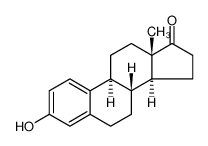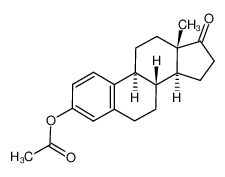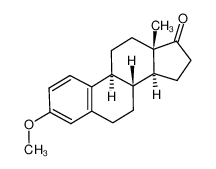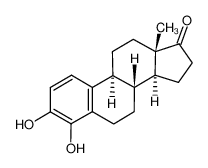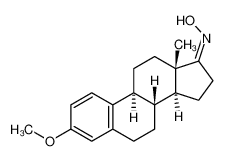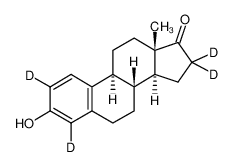| Product name | estrone |
|---|
| Product number | - |
|---|---|
| Other names | Femidyn |
| Identified uses | For industry use only. |
|---|---|
| Uses advised against | no data available |
| Company | MOLBASE (Shanghai) Biotechnology Co., Ltd. |
|---|---|
| Address | Floor 4 & 5, Building 12, No. 1001 North Qinzhou Road, Xuhui District, Shanghai, China |
| Telephone | +86(21)64956998 |
| Fax | +86(21)54365166 |
| Emergency phone number | +86-400-6021-666 |
|---|---|
| Service hours | Monday to Friday, 9am-5pm (Standard time zone: UTC/GMT +8 hours). |
Carcinogenicity, Category 2
Reproductive toxicity, Category 1A
Reproductive toxicity, Additional category for effects on or via lactation
2.2 GHS label elements, including precautionary statements| Pictogram(s) |  |
|---|---|
| Signal word | Danger |
| Hazard statement(s) | H351 Suspected of causing cancer H360 May damage fertility or the unborn child H362 May cause harm to breast-fed children |
| Precautionary statement(s) | |
| Prevention | P201 Obtain special instructions before use. P202 Do not handle until all safety precautions have been read and understood. P280 Wear protective gloves/protective clothing/eye protection/face protection. P260 Do not breathe dust/fume/gas/mist/vapours/spray. P263 Avoid contact during pregnancy and while nursing. P264 Wash ... thoroughly after handling. P270 Do not eat, drink or smoke when using this product. |
| Response | P308+P313 IF exposed or concerned: Get medical advice/ attention. |
| Storage | P405 Store locked up. |
| Disposal | P501 Dispose of contents/container to ... |
none
3.Composition/information on ingredients 3.1 Substances| Chemical name | Common names and synonyms | CAS number | EC number | Concentration |
|---|---|---|---|---|
| estrone | estrone | 53-16-7 | none | 100% |
Consult a physician. Show this safety data sheet to the doctor in attendance.
If inhaledIf breathed in, move person into fresh air. If not breathing, give artificial respiration. Consult a physician.
In case of skin contactWash off with soap and plenty of water. Consult a physician.
In case of eye contactRinse thoroughly with plenty of water for at least 15 minutes and consult a physician.
If swallowedNever give anything by mouth to an unconscious person. Rinse mouth with water. Consult a physician.
4.2 Most important symptoms/effects, acute and delayedno data available
4.3 Indication of immediate medical attention and special treatment needed, if necessary/SRP:/ Immediate first aid: Ensure that adequate decontamination has been carried out. If patient is not breathing, start artificial respiration, preferably with a demand valve resuscitator, bag-valve-mask device, or pocket mask, as trained. Perform CPR if necessary. Immediately flush contaminated eyes with gently flowing water. Do not induce vomiting. If vomiting occurs, lean patient forward or place on the left side (head-down position, if possible) to maintain an open airway and prevent aspiration. Keep patient quiet and maintain normal body temperature. Obtain medical attention. /Poisons A and B/
5.Fire-fighting measures 5.1 Extinguishing media Suitable extinguishing mediaWater spray, dry chemical, carbon dioxide, or foam as appropriate for surrounding fire and materials. ... As with all fires, evacuate personnel to a safe area. Firefighters should use self-contained breathing equipment and protective clothing.
5.2 Specific hazards arising from the chemicalno data available
5.3 Special protective actions for fire-fightersWear self-contained breathing apparatus for firefighting if necessary.
6.Accidental release measures 6.1 Personal precautions, protective equipment and emergency proceduresUse personal protective equipment. Avoid dust formation. Avoid breathing vapours, mist or gas. Ensure adequate ventilation. Evacuate personnel to safe areas. Avoid breathing dust. For personal protection see section 8.
6.2 Environmental precautionsPrevent further leakage or spillage if safe to do so. Do not let product enter drains. Discharge into the environment must be avoided.
6.3 Methods and materials for containment and cleaning upWear approved respiratory protection, chemically compatible gloves, and protective clothing. Wipe up spillage or collect spillage using a high-efficiency vacuum cleaner. Avoid breathing dust. Place spillage in appropriately labeled container for disposal. Wash spill site.
7.Handling and storage 7.1 Precautions for safe handlingAvoid contact with skin and eyes. Avoid formation of dust and aerosols. Avoid exposure - obtain special instructions before use.Provide appropriate exhaust ventilation at places where dust is formed. For precautions see section 2.2.
7.2 Conditions for safe storage, including any incompatibilitiesStore in the original package. Do not store above 25°C.
8.Exposure controls/personal protection 8.1 Control parameters Occupational Exposure limit valuesno data available
Biological limit valuesno data available
8.2 Appropriate engineering controlsHandle in accordance with good industrial hygiene and safety practice. Wash hands before breaks and at the end of workday.
8.3 Individual protection measures, such as personal protective equipment (PPE) Eye/face protectionSafety glasses with side-shields conforming to EN166. Use equipment for eye protection tested and approved under appropriate government standards such as NIOSH (US) or EN 166(EU).
Skin protectionWear impervious clothing. The type of protective equipment must be selected according to the concentration and amount of the dangerous substance at the specific workplace. Handle with gloves. Gloves must be inspected prior to use. Use proper glove removal technique(without touching glove's outer surface) to avoid skin contact with this product. Dispose of contaminated gloves after use in accordance with applicable laws and good laboratory practices. Wash and dry hands. The selected protective gloves have to satisfy the specifications of EU Directive 89/686/EEC and the standard EN 374 derived from it.
Respiratory protectionWear dust mask when handling large quantities.
Thermal hazardsno data available
9.Physical and chemical properties| Physical state | White crystalline powder |
|---|---|
| Colour | Small, white crystals, or white to creamy white, crystalline powder |
| Odour | Odorless |
| Melting point/ freezing point | 217°C(lit.) |
| Boiling point or initial boiling point and boiling range | 183°C |
| Flammability | no data available |
| Lower and upper explosion limit / flammability limit | no data available |
| Flash point | 9°C |
| Auto-ignition temperature | no data available |
| Decomposition temperature | no data available |
| pH | no data available |
| Kinematic viscosity | no data available |
| Solubility | In water:0.03 g/L |
| Partition coefficient n-octanol/water (log value) | no data available |
| Vapour pressure | 2.49X10-10 mm Hg at 25°C (est) |
| Density and/or relative density | 1.164 g/cm3 |
| Relative vapour density | no data available |
| Particle characteristics | no data available |
no data available
10.2 Chemical stabilityStable in air.
10.3 Possibility of hazardous reactionsno data available
10.4 Conditions to avoidno data available
10.5 Incompatible materialsno data available
10.6 Hazardous decomposition productsWhen heated to decomposition it emits acrid smoke and fumes.
11.Toxicological information Acute toxicity- Oral: no data available
- Inhalation: no data available
- Dermal: no data available
no data available
Serious eye damage/irritationno data available
Respiratory or skin sensitizationno data available
Germ cell mutagenicityno data available
CarcinogenicityEstrogens, Steroidal: known to be human carcinogens. /Estrogens, Steroidal/
Reproductive toxicityno data available
STOT-single exposureno data available
STOT-repeated exposureno data available
Aspiration hazardno data available
12.Ecological information 12.1 Toxicity- Toxicity to fish: EC50; Species: Danio rerio (Zebra danio, age 20 days posthatch); Conditions: freshwater, renewal, 26°C; Concentration: 0.078 ug/L for 18 days; Effect: whole body vitellogenin induction /100% purity
- Toxicity to daphnia and other aquatic invertebrates: no data available
- Toxicity to algae: no data available
- Toxicity to microorganisms: no data available
AEROBIC: Estrone exhibited approximately 38% mineralization in 33 days using 4 Mile Creek sediment, 56% mineralization in 33 days using Boulder Creek sediment, and up 90% mineralization using South Platte River sediments, Colorado. Sediments were collected downstream of local waste water treatment plants. Upstream sediments exhibited approximately 1, 1, and 1% mineralization, respectively(1). Estrone is biodegraded by sewage bacteria via ring cleavage, ultimately to carbon dioxide through a tricarboxylic acid cycle(2). C14-labeled estrone, present at 0.1 mg/kg, reached 2.0-17.4% mineralization in 21 days using natural German and Austrian soils in microcosm incubations maintained at 20°C(3,4). Soil-specific percent 14CO2 evolution values of 5.4, 4.6, 11.1, 2.0, and 17.4 were reported using Metelan (grassland, 3.3% SOC), Koeln (crop field, 0.7% SOC), Halle (crop field, 1.3% SOC), Gumpenstein (crop field, 2.2% SOC), and Hamapil (orchard, 1.5% SOC) soil microcosms, respectively(4).
12.3 Bioaccumulative potentialAn estimated BCF of 54 was calculated in fish for estrone(SRC), using a log Kow of 3.13(1) and a regression-derived equation(2). According to a classification scheme(3), this BCF suggests the potential for bioconcentration in aquatic organisms is moderate(SRC).
12.4 Mobility in soilThe Koc of estrone was reported as 2,000-18,000, using a Chelsea, MI topsoil (total organic carbon 5.45%)(1). Natural estrogens such as estrone are mainly removed from the aqueous phase by adsorption onto solids such as sludge in wastewater or soil in cases of land application(2). Sorption of estrone from CaCl2 solution and artificial urine in pastoral soils from North Island, New Zealand was studied. The log Koc values using Horotiu silt loam (pH 5.4; % OC 8.2; % Sand 34; % Silt 48; % Clay 17), Hamilton clay loam (pH 5.1; % OC 4; % Sand 19; % Silt 51; % Clay 30), and TeKowhai silt loam (pH 5.1; % OC 5; % Sand 9; % Silt 54; % Clay 37) were 2.66 and 2.75, 2.93 and 3.04, and 3.15 and 2.9, respectively(3), corresponding to Koc values of 457 and 562, 851 and 1096, and 1412 and 794, respectively(SRC). According to a classification scheme(4), these Koc values suggest that estrone mobility in soil is moderate to immobile. In soils with a long history of treatment with manure, biosolids, or wastewater, sorption of estrone becomes dependent on soil organic carbon content (SOC). Kd values of 122, 46, 134, 72, and 67 mL/g were reported using Metelan (grassland, SOC 3.3%), Koeln (crop field, 0.7% SOC), Halle (crop field, 1.3% SOC), Gumpenstein (crop field, 2.2% SOC), and Hamapil (orchard, 1.5% SOC) soils in Germany, respectively(5). A Kd of 402 L/kg was reported using activated sludge(6).
12.5 Other adverse effectsno data available
13.Disposal considerations 13.1 Disposal methods ProductThe material can be disposed of by removal to a licensed chemical destruction plant or by controlled incineration with flue gas scrubbing. Do not contaminate water, foodstuffs, feed or seed by storage or disposal. Do not discharge to sewer systems.
Contaminated packagingContainers can be triply rinsed (or equivalent) and offered for recycling or reconditioning. Alternatively, the packaging can be punctured to make it unusable for other purposes and then be disposed of in a sanitary landfill. Controlled incineration with flue gas scrubbing is possible for combustible packaging materials.
14.Transport information 14.1 UN Number| ADR/RID: UN1230 | IMDG: UN1230 | IATA: UN1230 |
| ADR/RID: METHANOL |
| IMDG: METHANOL |
| IATA: METHANOL |
| ADR/RID: 8 | IMDG: 8 | IATA: 8 |
| ADR/RID: I | IMDG: I | IATA: I |
| ADR/RID: no | IMDG: no | IATA: no |
no data available
14.7 Transport in bulk according to Annex II of MARPOL 73/78 and the IBC Codeno data available
15.Regulatory information 15.1 Safety, health and environmental regulations specific for the product in question| Chemical name | Common names and synonyms | CAS number | EC number |
|---|---|---|---|
| estrone | estrone | 53-16-7 | none |
| European Inventory of Existing Commercial Chemical Substances (EINECS) | Listed. | ||
| EC Inventory | Listed. | ||
| United States Toxic Substances Control Act (TSCA) Inventory | Listed. | ||
| China Catalog of Hazardous chemicals 2015 | Not Listed. | ||
| New Zealand Inventory of Chemicals (NZIoC) | Listed. | ||
| Philippines Inventory of Chemicals and Chemical Substances (PICCS) | Not Listed. | ||
| Vietnam National Chemical Inventory | Not Listed. | ||
| Chinese Chemical Inventory of Existing Chemical Substances (China IECSC) | Not Listed. | ||
| Creation Date | Aug 12, 2017 |
|---|---|
| Revision Date | Aug 12, 2017 |
- CAS: Chemical Abstracts Service
- ADR: European Agreement concerning the International Carriage of Dangerous Goods by Road
- RID: Regulation concerning the International Carriage of Dangerous Goods by Rail
- IMDG: International Maritime Dangerous Goods
- IATA: International Air Transportation Association
- TWA: Time Weighted Average
- STEL: Short term exposure limit
- LC50: Lethal Concentration 50%
- LD50: Lethal Dose 50%
- EC50: Effective Concentration 50%
- IPCS - The International Chemical Safety Cards (ICSC), website: http://www.ilo.org/dyn/icsc/showcard.home
- HSDB - Hazardous Substances Data Bank, website: https://toxnet.nlm.nih.gov/newtoxnet/hsdb.htm
- IARC - International Agency for Research on Cancer, website: http://www.iarc.fr/
- eChemPortal - The Global Portal to Information on Chemical Substances by OECD, website: http://www.echemportal.org/echemportal/index?pageID=0&request_locale=en
- CAMEO Chemicals, website: http://cameochemicals.noaa.gov/search/simple
- ChemIDplus, website: http://chem.sis.nlm.nih.gov/chemidplus/chemidlite.jsp
- ERG - Emergency Response Guidebook by U.S. Department of Transportation, website: http://www.phmsa.dot.gov/hazmat/library/erg
- Germany GESTIS-database on hazard substance, website: http://www.dguv.de/ifa/gestis/gestis-stoffdatenbank/index-2.jsp
- ECHA - European Chemicals Agency, website: https://echa.europa.eu/





